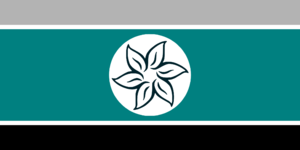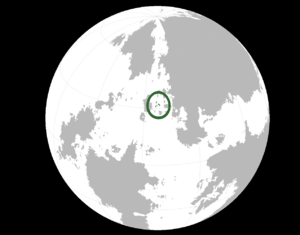Difference between revisions of "Archive:Sialia"
| Line 287: | Line 287: | ||
Each Emirate also has a symbol, this time faunal, which is borne on their flags also. These are used only by local governments. | Each Emirate also has a symbol, this time faunal, which is borne on their flags also. These are used only by local governments. | ||
Another national symbol is the [[Wikipedia:Carcinus aestuarii|Sialian Turkey Crab]], which is an indigenous (and endemic) delicacy - highly priced, and highly sought after by foreign culinary experts. | |||
Revision as of 17:23, 30 May 2016
| The Confederation of Sialan Emirates Njanêj Sjálâfý Falâjýfua |
||||
|---|---|---|---|---|
|
||||
| Motto: "" | ||||
| Anthem: '' Royal anthem: '' |
||||
| [[File:|center|250px|alt=The Locaton of Sialia on Sahar|The Locaton of Sialia on Sahar]] The Location of Sialia on Sahar
|
||||
| Largest city | capital | |||
| Official languages | Sialan | |||
| Demonym | Sialan | |||
| Government | Federal semi-presidential constitutional oligarchy | |||
| - | President | |||
| - | Premier | |||
| Legislature | Assembly | |||
| - | Upper house | Emirate Council and Board of Islands | ||
| - | Lower house | National Assembly | ||
| GDP (PPP) | 2015 estimate | |||
| - | Total | 51246 | ||
| HDI (2015) | 0.945(GNII = 0.992; EPI = 0.942; LEI = 0.900) very high |
|||
| Currency | Sialan Sênam (SLS) | |||
| Time zone | WŠT (SCT-1) | |||
| - | Summer (DST) | SCT (CŠT) (SCT+0) | ||
| Antipodes | Marine, Asura Ocean | |||
| Date format | dd.mm.yyyy | |||
| Drives on the | left | |||
| Calling code | +290 | |||
| Internet TLD | .si | |||
Sialia (IPA: /siʲɑ:liʲə/, Native language: Sjálâ, IPA: /sʲa:liʲ'a/), officially The Confederation of Sialan Emirates, is a country located due West of Laefevia, in the Dragon Sea, near the Šarkunen peninsula.
Etymology
The native name, Sjáliâ is a contraction of the noun sjál (meaning garden), and the country suffix -iljâ. Thus, in ancient times, the country would have been known as Sjáliljâ (lit. country of gardens).
History
Geography
Geology
Sialia is dominated by its volcanology. Formed by a series of shield volcanoes, it is composed of mainly basaltic rocks which give its cliffs a distinctive black colour. Some areas are still volcanically active, leading to the use of geothermal power in the magmatic fissures (see #Energy, below). Much of the coastline is composed of harsh cliffs, with caves carving into the sides. In areas eroded by the sea, however, bays are formed with shallow beaches, protected from the ocean.
Climate
Sialia’s climate varies with wind direction. It has an average temperature range of 10-35 °C, with 725-974 mm per annum of rain. If the wind blows from the north or south, the climate is noticeably wetter due to winds over the sea. From the East and West, Sialia is sheltered from the worst of the weather, creating a drier climate during the summer. It is comparable to the Mediterranean climate (on Earth), particularly areas around Sicily or southern Italy.
Biodiversity
Dominated by open plains, and populated with olive trees and other hardwoods in the flatter areas, Sialia has a rich phytodiversity. Higher up on the volcano slopes, however, the land turns more to scrub, with short bushes dotting the rocky landscape.
In terms of animals, cattle ranching is often practised inland, leading to large pastures of the hardy grass which is found on these islands. Another notable feature of the Sialan biodiversity is the Sialian Turkey Crab.
Government
Executive Government
The State is headed by the President, who runs as an Independent, politically speaking. The President has a largely ceremonial role, but does have political power in standing as the Emir of the Capital region. The President, does not, however sit on the Emirate Council - but they are responsible for officially electing a Premier (who is chosen by the Council).
The Premier is the head of state, and has a role identical to that of a Prime Minister. The Premier is responsible for ensuring the Board Leaders are fulfilling their required tasks (known as Portfolios), and also for serving as Leader of the Board of the State.
A third important role in the Government is the Leader of the National Assembly, colloquially known as the Prime Leader. It was not felt the Emirate Council needed a Chairperson, as it consists of only 5 members. The Prime Leader is also independent from any political parties, and serves as an objective moderator and enabler of the discussion that takes place in the National Assembly.
There are 16 Boards in the Sialan Government, and these (along with their Portfolios) are summarised below. There are 2 major Boards (listed first) - whose functions are considered to be vital to international stability. Then, there are 12 minor Boards - whose functions are considered to be vital to national security. Lastly, there are 2 Boards, which have been created only recently, to deal with relatively modern issues. There were propositions to create a 17th Board - the Board of Cybersecurity - but these roles were instead assumed by the Board of Defence.
Interior Board
Exterior Board
Board of Administration
Board of Culture
Board of Defence
Board of Economics
Board of Education
Board of Enterprise
Board of Health
Board of Infrastructure
Board of Justice
Board of Regulation
Board of Statistics
Board of War
This Board does not have a permanent Board Leader, as it is not always necessary. In times of civil and international unrest, this board is jointly headed by the Premier and the Board Leader of Defence, and is responsible for (contrary to the name) conducting emergency diplomatic procedures and negotiations, so as to achieve peace. In times of relative international peace, this Board is considered a proxy of the Sialan Diplomatic Missions (excluding those in the Šarkunen peninsula), which all can operate under - this gives them greater authority, and the ability to grant temporary official documents (like emergency passports and National ID cards). In recent times, there have been petitions to rename this board to the Board of Diplomacy, and these are currently being reviewed by the Emirate Council; a decision is expected soon.
Green Board
This Board was previously known as the Board of Fishing and Agriculture, but it has since been granted extra power, and is now responsible for overseeing and regulating all Sialan environmental affairs.
____ Board
Legislative Government
In the Sialan Government, almost all of the legislative power is vested in the National Assembly, with some also in the Emirate Council. The Legislation, therefore, is bicameral.
The Upper House (the Emirate Council and Board of Islands) has the power to veto any bill, with a 4/5 majority. It's other function is to decide on a Premier (Head of Government), who is officially nominated by the President (Head of State). This House is comprised the Emirs from each of the 5 emirates.
The Lower House (the National Assembly) is made of a number Delegates from each Emirate, proportional to the population of that Emirate. This is usually judged as 1 Delegate per 2 Prefectures. Bills submitted to this chamber under go the following processes before being debated:
- The bill is examined for possible offence-causing material by the Board of Administration.
- The bill is checked for factual and grammatical errors by the Board of Regulation.
- The proposer of the bill is contacted by the Board of Statistics for:
- The formulation of an argument;
- The provision of relevant statistics; and
- The distribution of information to all Assembly Delegates.
- The proposer is submitted to the Board of Regulation for a further examination of the new argument.
After this rigorous process, the bill is debated by the NADs (National Assembly Delegates), and all those supporting the bill sit on the right, while all those opposing the bill sit on the left. The impartial Assembly Leader, and all Board Leaders sit at the back of the chamber. The proposer stands at the lectern in the centre, flanked by his pre-nominated deputies. Non-voting members of the Boards of Regulation and Administration sit in the outer circles.
Judiciary Government
Politics
Administrative divisions
Sialia is split up into 5 Emirates (1, 2, 3, 4, and 5). Each of these are partially autonomous, and is ruled by an Emir (Sialan: nján). The sixth division is the Capital City (6), which follows the national laws, and (where there are gaps) those of the surrounding Emirate (1).
Each Emirate is further divided into prefrectures, but these are purely for administration in local governments.
Foreign relations
Military
Economy
Imports
Exports
Aside from fishing and tourism (the several volcanoes which make up the islands are incredibly popular with holidaymakers), Sialia’s main export is the Sialian Turkey Crab.
The crab tastes of something you have just scraped off your boot and even with proper cooking has the texture of a car tyre, however it is only found off the cliffs of one of the islands and so is incredibly rare, making it a global delicacy and so highly sought after. It was almost fished to extinction in the 1800s, however highly strict rules have since been put in place to protect it and numbers have bounced back.
Transport
Energy
Sialia has pledged completely carbon-neutral in its energy production by 2020, thus creating all of its power from geothermal and wave energy.
Science and technology
Tourism
Demographics
Ethnic groups
Urbanisation
Language
The language spoken in Sialia is Sialan (natively: Sjálâ). It is related to Læfêvëši, the language of their neighbours - both are daughter languages of Proto-Enkean (a reconstructed langauge).
Education
Healthcare
Religion
Culture
Heritage
Architecture
Much of the architecture on Sialia is white plaster walls with shallow terracotta roofs, although domes or flat roofs are not uncommon.
The traditional form is that of a half-sunken basement forming the ground floor, to shelter from the sun. The windows themselves are heavily shuttered to protect against the midday sun and the storms which occasionally blow in from the south. Balconies are prevalent on top of an extended section of basement, creating a decking raised just above the ground. Entrances are half lowered into the ground, level with the basement, with thin slit windows placed horizontally across this basement to look out across the ground.
Often the houses will have a small tower to catch the wind which blows across the islands in the Earthly Middle-Eastern style of a wind tower, to cool the houses and sometimes create extra living space, although the main body of the house is usually a two-storey dwelling. These are known as Windcatchers (Sialan: lôjsëlerikán).
Literature
Art
Music
Theatre
Film
Cuisine
Sport
Mythology
The most popular mythological creature, rumoured to have existed on Sialian soil long ago is the Sorcerer's Snake. This is a rainbow coloured snake, and is now seen as a symbol of equality throughout Sialian society.
Symbols
The main national symbol in Sialia is the floral emblem that features on the National Flag. This is used heavily by patriotic citizens and on all official documents.
Each Emirate also has a symbol, this time faunal, which is borne on their flags also. These are used only by local governments.
Another national symbol is the Sialian Turkey Crab, which is an indigenous (and endemic) delicacy - highly priced, and highly sought after by foreign culinary experts.

